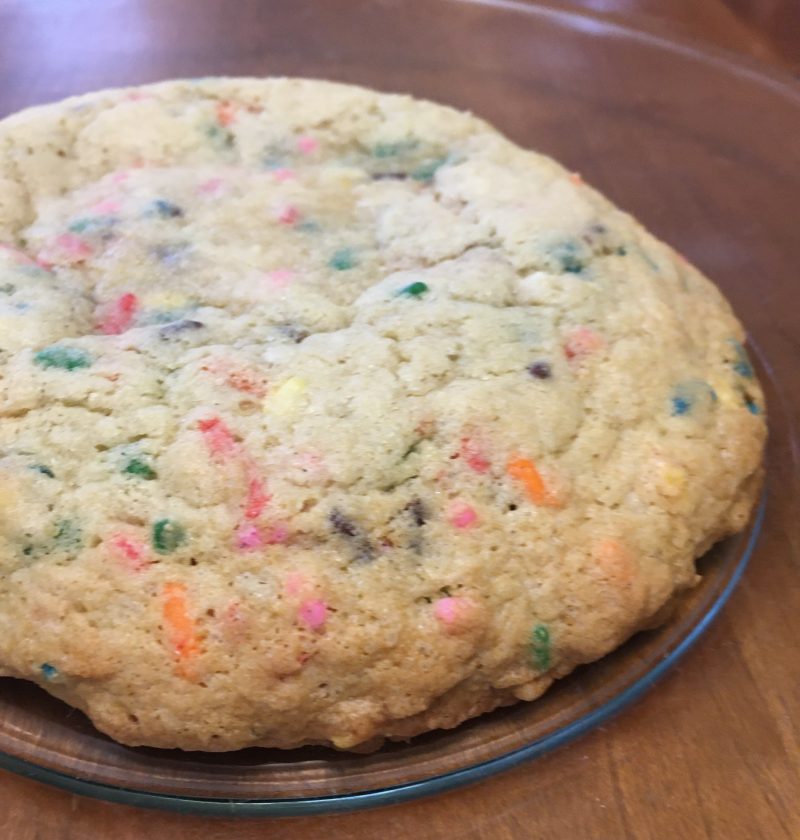
Introduction:
Have you ever wondered why certain ingredients are in a recipe? What is the role of each ingredient? We are going to uncover what makes a GIANT sugar cookie perfect by looking into each ingredient’s effect.
Scientific Content:
What does each ingredient do?
- 2 Tablespoons unsalted butter, softened to room temperature
- Purpose: To bind and soften.
- Butter is 20% water and 80% fat. The fat will make the flour and sugar stick together and prevents gluten from forming networks (prevents a tough cookie). Butter also contributes to flavor and the appearance of the cookie. The proteins, flavor molecules and sugar have an affect on the cookie. The proteins will impact the color of the cookie, the flavor molecules will affect the flavor, and the proteins and sugar can react to cause brown color (Maillard Reaction) (“Role of flour, butter,” 2020).
- Purpose: To bind and soften.
- 3 Tablespoons granulated sugar
- Purpose: Browning and Crisping.
- Besides the obvious sugar= sweetness, sugar participates in caramelization and the Maillard Reaction to create a brown cookie. Cookies will also have their crispiness affected by sugar. Without adding sugar to butter and flour you have a soft consistency for the cookie. Sugar dissolves in water so the more moisture your cookie has the more the sugar will dissolve and then recrystallize after cooling (“Role of flour, butter,” 2020).
- Purpose: Browning and Crisping.
- 2 Tablespoons beaten egg (crack the egg, beat it, and use 2 tbsp)
- Purpose: Lends an important helping hand to other ingredients.
- Eggs provide fat, protein, water, and lecithin (an emulsifier). When it comes to the structure, eggs will hold your cookies together and give them their shape. If there is too much egg your cookie will puff up instead of spreading out. Specifically looking at the yolk, these are important for a chewy cookie. The fat in the yolk tenderizes the dough (shortens the gluten strands). The yolk also creates our creamy batter because of the emulsification qualities. The egg white will do the opposite. It will dry out your cookie if there is not enough sugar. As for the other ingredients that receive benefits from the egg, sugar uses the fat to enhance its flavor, the dough uses water & lecithin, and the Maillard reaction uses the yolks for browning (Parks, 2019).
- Purpose: Lends an important helping hand to other ingredients.
- 1/2 teaspoon pure vanilla extract
- Purpose: Flavor Enhancer
- Without adding vanilla extract to cookies, they end up falling flat and losing their flavor. Vanilla is the main source of flavor in our cookie besides the sugar (Christianson, 2019).
- Purpose: Flavor Enhancer
- 6 Tablespoons all-purpose flour
- Purpose: To develop the cookie.
- Two important parts of flour are gluten (proteins) and starch (carbohydrate). For gluten you don’t want it to overdevelop, so that’s why you don’t knead the dough intensely or else it will stiffen. The gluten proteins will also denature in the oven (change proteins by chemical or physical means) and solidify in structure. As for the starch, it absorbs water which creates a firmer dough. As a cookie is cooked the starch will also “cook” absorbing more water and thickening the structure of the cookie (“Role of flour, butter,” 2020).
- Purpose: To develop the cookie.
- 1/4 teaspoon baking soda
- Purpose: Leavening Agent & pH Raiser
- Sodium Bicarbonate creates air pockets in the cookies when combined with an acid and liquid. it also creates an alkaline environment which then slows down protein coagulation, gives the dough more time to spread before the eggs cook, and weakens gluten. This creates a more tender cookie and promotes a uniform thickness for a cookie (Parks, 2019).
- Purpose: Leavening Agent & pH Raiser
- 1/4 teaspoon salt
- Purpose: Secondary Flavor Enhancer & Back up Strengthener
- Without having salt in the recipe the sweetness would take over. Salt balances out the right amount of sweetness. Aside from balancing the flavor, the salt also acts in strengthening the proteins in the dough, making the cookies chewier (Joachim, 2018).
- Purpose: Secondary Flavor Enhancer & Back up Strengthener
- 1/4 teaspoon cream of tartar
- Purpose: Acidity & Stability
- Cream of tartar is a stabilizer due to its effect of keeping the dough fluffy, allowing it to rise when baked. Another factor is that cream of tartar keeps sugar from crystalizing and creating an undesirable texture. Cream of tartar adds no extra taste or odor when added with the baking soda, only the air bubbles. It is also not a liquid and won’t alter the dough’s composition (Manley, 2020).
- Purpose: Acidity & Stability
- 2 Tablespoons sprinkles
- Purpose: For Fun
- The sprinkles add nothing more than color and fun to the recipe. There is no added flavors and no other chemical reactions that occur due to this additive.
- Purpose: For Fun
How does the process effect my recipe?
- Temperatures Associated with the Recipe:
- Room Temperature Butter: Having the butter at room temperature helps the ingredients mix into the recipe more evenly and your dough will thus be room temperature instead of cool.
- Oven Temperature: (This mostly applies to pre-heating before starting any mixing) If you put your cookies in the oven and the temperature is not right, then the dough can spread instead of firm up (in our case making a XXXXL cookie). This is going to affect the thickness, browning, and texture of our cookie (Joachim, 2018).
- Order Ingredients Are Mixed:
- Cream Butter and Sugar: Mechanical Leavening- By folding the butter and sugar together it creates tiny air pockets. With the addition of the sugar it enhances this air creation and creates a dense texture (Parks, 2019).
- Mix in Vanilla and Eggs: Adding in the eggs and vanilla at this stage creates more liquid for the sugar to dissolve in. As for air pockets, since the egg is pre-whisked and added, then there is limited air that can be added in (“Mixing Dough or Batter,” n.d.).
- Dry Ingredients- Mixing the dry ingredients together before adding them individually in the wet bowl makes sure that over-mixing doesn’t occur and that the dry ingredients are evenly distributed (“Mixing Dough or Batter,” n.d.).
- Adding dry to wet- Slowly adding in the dry ingredients creates an easier dough where there is air being folded in and overmixing isn’t a problem. Also, the bowl won’t have crusty flour on the sides which is a result of overmixing (“Mixing Dough or Batter,” n.d.).
- Cookie Sheet
- Aluminum Cookie Sheet: Using an aluminum cookie sheet allows for the cookies to bake evenly without burning them on the bottom. Thick aluminum conducts heat better than most other metals. When using these sheets you have to add parchment paper or a silicone baking mat so the cookie doesn’t stick (Leigh, n.d.).
- Rack Positioning
- Top Rack: This positioning is the farthest from the heat source and so often times results in the cookies spreading too much (Naglich, 2019).
- Middle Rack: This is the ideal position because it offers the most evenly distributed heat and air circulation, allowing for the cookies to bake consistently (Naglich, 2019).
- Bottom Rack: The bottom rack is often too close to the heat source and will burn the bottoms of the cookies before the top cooks (Naglich, 2019).
- Utensils Used
- Whisk: A whisk was used for mixing the dry ingredients together. Using a whisk to mix the dry ingredients together allowed for some sifting to occur and made sure that ever ingredient was being dispersed.
- Rubber Spatulas: This tool was used for the majority of the mixing. For the creaming it added air and was easy to smash the butter along the sides. When it came to mixing the dry into the wet this was the tool used because it could scrap anything off the sides and anything that got stuck to it was easy to scrap off. The folding ability of the tool was a great help in not over mixing.
Ingredients
Instructions
-
Preheat oven to 350°F (177°C). Spray cookie sheet with nonstick spray or use a silicone baking mat.
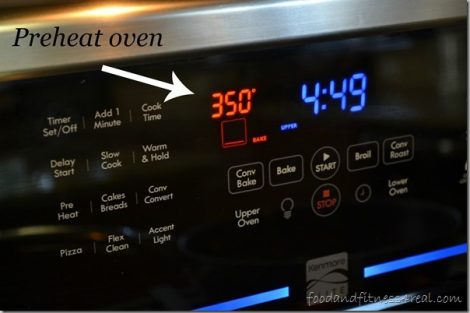
-
In a medium-sized mixing bowl, stir the butter and sugar together until creamed. Mix in the egg and vanilla.
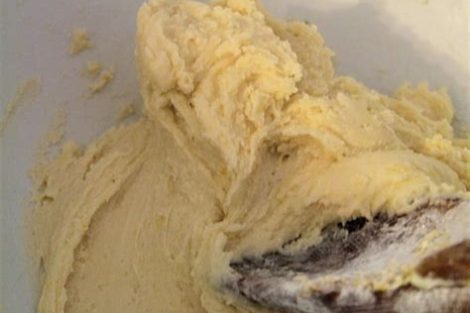
-
Stir in flour, baking soda, salt, cream of tartar, and sprinkles until just combined. Do NOT overmix.
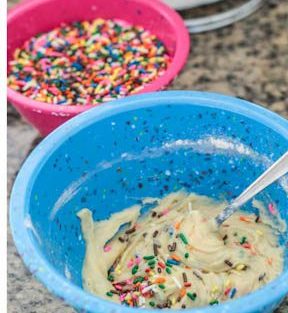
-
Place the dough in the center of the prepared cookie sheet into a tall ball (see picture above).
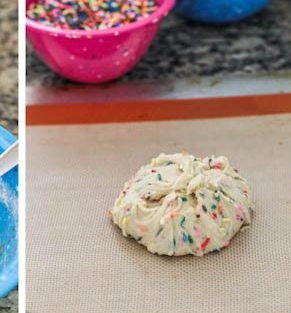
-
Bake for 14-16 minutes until the edges are browned. The center may appear undone but that’s what you want. It will firm up. Allow to cool completely ON the baking sheet.
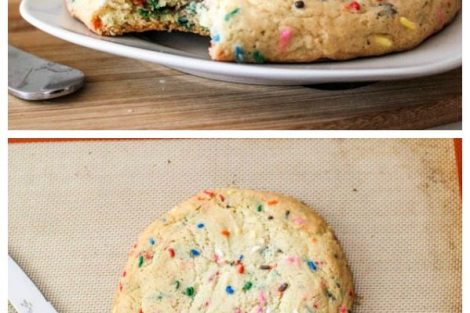
Notes
Christensen, E. (2019, June 5). Baker's Best Friend: Vanilla Extract. Retrieved from https://www.thekitchn.com/bakers-best-friend-vanilla-extract-ingredient-spotlight-170316
Davison, J. C., Lancaster, B., Bishop, J., Souza, D., McManus, L., Shaw, T., Roof, B. (2012). Two leaveners are often better than one. The Science of Good Cooking (pp. 358-359). America’s Test Kitchen.
Joachim, D., & Schloss, A. (2018, July 19). The Science of Baking Cookies - Magazine. Retrieved from https://www.finecooking.com/article/the-science-of-baking-cookies-2
Leigh, K. (n.d.). Can a Cookie Sheet Affect the Baking of the Cookies? Retrieved from https://www.livestrong.com/article/484983-can-a-cookie-sheet-affect-the-baking-of-the-cookies/
Manley, T., & Skola, S. (2020, February 29). What Is the Importance of Cream of Tartar in Cookies? Retrieved from https://www.wisegeek.com/what-is-the-importance-of-cream-of-tartar-in-cookies.htm
Mixing Dough or Batter: Wet into Dry or Dry into Wet? (n.d.). Retrieved from https://www.cooksillustrated.com/how_tos/6522-mixing-dough-or-batter-wet-into-dry-or-dry-into-wet
Naglich, M. (2019, March 20). This Is the Best Oven Rack Position for Baking Cookies. Retrieved from https://www.tasteofhome.com/article/the-best-oven-rack-position-for-baking-cookies/
Parks, S. (2019, November 4). Cookie Science: How Do Eggs Affect My Cookies? Retrieved from https://www.seriouseats.com/2015/12/cookie-science-how-do-eggs-affect-my-cookies.html
Parks, S. (2019, November 6). How Baking Soda Works. Retrieved from https://www.seriouseats.com/2015/12/cookie-science-how-baking-soda-works.html
Parks, S. (2019, October 29). Cookie Science: Why Cream Butter and Sugar? Retrieved from https://www.seriouseats.com/2015/12/cookie-science-creaming-butter-sugar.html
Potter, J. (2015). Air and water. Cooking for Geeks (pp.273-275). O’Reilly Media Inc.
Provost, J. J., Colabroy, K. L., Kelly, B. S., & Wallert, M. A. (2016). The science of cooking: Understanding the biology and chemistry behind food and cooking. Retrieved from https://envoy.dickinson.edu:6499
Role of flour, butter and sugar in cookies - Shortbread science. (2020, January 2). Retrieved from https://foodcrumbles.com/ultimate-cookie-series-5-shortbread-basics/
Sally. (2012, May 3). XXL Buttery Soft Sugar Cookie. Retrieved from https://sallysbakingaddiction.com/xxl-buttery-soft-sugar-cookie/#tasty-recipes-76778
Swartz, I. (2017, September 26). The Science Behind: Baking Powder and Baking Soda. Retrieved from https://medium.com/show-some-stempathy/the-science-behind-baking-powder-and-baking-soda-2f2a014f1000
The Role of Eggs in Baking Cookies. (2014, January 6). Retrieved from http://www.lifemadesweet.com/role-eggs-baking-cookies/
Picture Citations:
Ojwalker. (2015, April 23). Easy How To (Bake A Cake). Retrieved from https://ojwalker.wordpress.com/2015/02/25/purpose/
Sally. (2012, May 3). XXL Buttery Soft Sugar Cookie. Retrieved from https://sallysbakingaddiction.com/xxl-buttery-soft-sugar-cookie/#tasty-recipes-76778